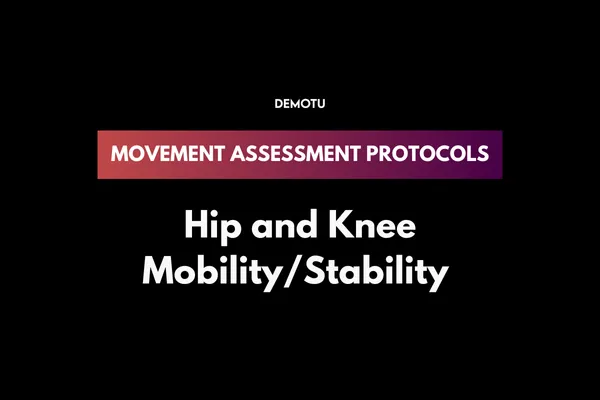
Hip and Knee Mobility/Stability Protocol for Injury Prevention in Athletes
Movement Analysis, Workout Builder
For athletes engaged in running and jumping sports, hip mobility and knee stability are fundamental to both performance and injury prevention. Imbalances in these areas can lead to a range of lower extremity injuries, such as ACL tears, hip impingements, and chronic knee pain. Demotu’s Hip and Knee Mobility/Stability Protocol provides Athletic Trainers with an efficient and reliable way to assess the functional health of the hip and knee, enabling early identification of imbalances and targeted corrective interventions.
By implementing this protocol, Athletic Trainers can help athletes maintain optimal hip and knee function, improving performance while reducing injury risk.
Hip and Knee Mobility/Stability Protocol
Functional Assessments
1. Single Leg Hinge
Focus: Hip stability
The single leg hinge is a foundational assessment for evaluating hip stability and balance. In this test, the athlete stands on one leg and performs a hip hinge, similar to a single-leg deadlift, while maintaining control through the hip and knee. This movement requires coordinated engagement of the glutes, hamstrings, and core. Observing the athlete’s stability and alignment during the hinge can reveal weaknesses or asymmetries in hip stability that might contribute to knee or lower back injuries.
2. Lateral Lunge
Focus: Hip mobility and knee control
The lateral lunge is an effective assessment for hip mobility and knee control. Instruct the athlete to step to the side into a deep lunge, bending one knee while keeping the opposite leg extended. This movement challenges the hip’s ability to move freely in different planes, while also testing the knee’s stability during lateral shifts. Look for signs of restricted hip mobility, poor balance, or knee instability, which can indicate areas requiring targeted strengthening or mobility work.
Joint Comparisons
Hip Flexion/Extension: Assess the range of motion in hip flexion and extension to determine if

any imbalances or restrictions are present. Limited hip flexion or extension can alter movement patterns, increasing stress on the knees and lower back.
Hip Internal/External Rotation: Evaluate the athlete’s ability to rotate the hip inward and outward. Imbalances here are common in athletes and may lead to compensatory movement patterns that elevate the risk of injury.
Knee Flexion/Extension: Measuring knee flexion and extension range of motion provides insight into knee joint health and potential restrictions. Reduced knee flexion or asymmetry between knees can indicate underlying issues that may compromise stability and increase injury risk.
Research & Insights
Research shows a strong link between hip and knee mobility imbalances and lower extremity injuries in sports that involve high-impact, repetitive movements like running and jumping. Poor hip mobility often leads to compensatory patterns that stress the knees, while weak or unstable knee function can make athletes more vulnerable to ligament injuries, such as ACL tears. By incorporating hip and knee assessments into regular evaluations, Athletic Trainers can help identify and correct these issues before they lead to injury.
How Demotu’s Protocol Supports Injury Prevention
Demotu’s Hip and Knee Mobility/Stability Protocol is designed with Athletic Trainers in mind, providing quick, effective assessments for tracking hip stability and knee control over time. Our system enables you to monitor athletes’ joint health and detect early signs of imbalance or instability, equipping you with the data needed to make informed training decisions.
Using Demotu, you can also create personalized exercise plans to address specific weaknesses identified during these assessments. For example, athletes with limited hip internal rotation may benefit from targeted hip mobility exercises, while those showing knee instability during lateral lunges may require additional knee stabilization work. Our workout builder and exercise builder features make it easy to implement these corrective strategies, ensuring athletes receive the support they need to stay healthy and perform at their peak.
Corrective Exercises and Workouts for Improved Hip and Knee Function
Demotu’s platform goes beyond assessment, offering tools to develop corrective exercises that improve hip and knee function. Incorporating exercises like hip flexor stretches, glute activation drills, and knee stabilization routines can directly address the mobility and stability needs identified during the assessment.
For example:
Hip Stability: Single-leg deadlifts and hip bridges can strengthen the muscles around the hip joint, promoting stability and control.
Hip Mobility: Dynamic stretches like lateral lunges and deep squats enhance hip range of motion, helping athletes move more efficiently.
Knee Stability: Exercises like step-downs and single-leg squats focus on knee alignment and control, reducing the risk of knee-related injuries.
By consistently working on these areas, Athletic Trainers can help athletes develop the functional strength and flexibility necessary for optimal hip and knee health.
Click Here To Use Motion Capture for Movement Assessments - Free Today!